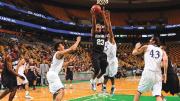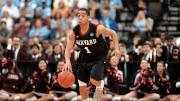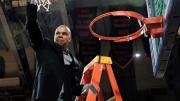On a Saturday evening in early March 2011, Harvard men’s basketball coach Tommy Amaker stood in the team’s locker room preparing to give one of the most important speeches of his Crimson career. In just a few minutes, Harvard would take the floor against Princeton, with a chance to capture at least a share of its first Ivy League championship, and Amaker wanted to impress upon his players, seated before him, the magnitude of the opportunity. To do so, he referenced the white board behind him—where earlier in the week he had asked each team member to sign his name and pledge his maximum effort. Now he narrowed their focus: they had worked hard to get here, but they needed to direct their entire focus to this one crucial moment.
When the current Harvard team convened for practice last fall, the signatures on that wall had long since been erased. But the sentiment they represented—that the players had an extraordinary opportunity to leave their mark on Harvard basketball—has endured. As Wesley Saunders ’15 told The Boston Globe earlier this year, the senior class in particular talked about the importance of solidifying their “legacy.”
Mission accomplished. After initially grappling with offensive inconsistency, this year’s team—particularly its seven seniors—came together to lead the Crimson to its fifth straight conference championship and fourth consecutive NCAA tournament berth. But given the graduation of so much talent, a season in which the rest of the league demonstrated newfound strength, and lingering uncertainty about Amaker’s trajectory and Harvard’s timeline for constructing a new arena, can the men’s program sustain—and ultimately build on—this success?
Early-Season Highs—and Lows
After a narrow loss to Michigan State in the round of 32 in the 2014 NCAA tournament, many thought this year’s squad would be the first in program history to reach the second weekend of March Madness. The Crimson returned Saunders, the reigning Ivy League Player of the Year; All-Ivy point guard Siyani Chambers ’16; and a host of front court talent. As a result, Harvard was a unanimous pick to win the league in the pre-season media poll, and the squad cracked the Associated Press’s pre-season top-25, the first such recognition for an Ivy squad since 1974.
It took just two games to deflate the hype. After defeating MIT, a Division III opponent, the Crimson fell 58-57 to Holy Cross, a middling program that would finish the season two games below .500. The loss immediately knocked Harvard from the national rankings—and raised real concerns. Other than Saunders, who scored 24 points, no Crimson player tallied more than nine; in the past, the Crimson had won with a balanced attack, but this team seemed frighteningly one-dimensional. More disturbing, as Saunders said, was that Holy Cross exhibited greater “intensity”—a comment hinting at a leadership void. If the Crimson could not muster the desire to defend its top-25 ranking against a middling foe, how would the team compete in Ivy League play, let alone the NCAA tournament?
A six-game win streak temporarily allayed these concerns, but the buoyant feeling evaporated during the holidays when the University of Virginia, then ranked fifth in the country, annihilated the Crimson 76-27, and Harvard suffered closer losses to Arizona State and Boston College. For the first time since the 2006-2007 season, the team had failed to defeat a high-major opponent (a representative of a leading NCAA league such as the Atlantic Coast Conference [ACC]).
Meanwhile, the rest of the league was nationally competitive. Brown knocked off Providence, an NCAA tournament team. Columbia led top-ranked Kentucky in the second half. Most remarkably, Yale defeated the University of Connecticut, the defending national champion, on a buzzer-beater in Storrs.
The Ivies
As conference competition began, these colliding forces yielded an excruciating loss. On a chilly January day, the Crimson hosted Dartmouth, a team it had beaten by double digits in Hanover two weeks earlier. But after Harvard pulled ahead by 14 points to start the second half, the Big Green unleashed a 26-2 run and won 70-61. The unnerving loss dropped the Crimson to 1-1 in the league—a significant consideration because Ivy teams, lacking a championship tournament, have an extremely narrow margin of error to be selected for the NCAA or other postseason opportunities.
Harvard’s play was even more alarming. The offense was again anemic. Even Saunders, who along with Chambers led Harvard with 13 points, struggled to find a rhythm—in part a byproduct of sound defense: Dartmouth packed the paint, essentially daring Harvard to make outside shots; they didn’t. But the Crimson’s lapses also suggested that Dartmouth, as Saunders acknowledged, had played “harder.”
In light of that admission, Harvard’s metamorphosis during the next four weeks was remarkable: the Crimson won eight consecutive games—the first four of them on the road. The highlight was a 52-50 victory over Yale in New Haven. The Bulldogs had been undefeated in conference play and had an opportunity to take a two-game Ivy lead over the Crimson. But Harvard locked in on defense and did just enough on offense, preserving the team’s chance for another conference title.
Across the board, the team was playing better. The offense became more balanced. At Princeton, Corbin Miller ’15 (’17) nailed five three-pointers to lead Harvard in scoring. Against Columbia, Saunders led the Crimson with 18 points, but three teammates also scored in double figures.
After a series of players-only meetings, the Crimson brought greater urgency to the court. As Jonah Travis ’15 observed, the team realized that it was suffering from an embarrassment of riches: with seven seniors, it had many players who were capable of leading, but no one was asserting control. The seniors, Travis explained, needed to meld their skills.
But after the Crimson’s win streak ended with a 57-49 loss at Cornell, none of that guaranteed the Ivy championship. The stumble dropped Harvard into a tie with Yale atop the conference with two games to go. Fittingly, the Crimson (20-6, 10-2 Ivy) hosted the Bulldogs (21-8, 10-2 Ivy) in the penultimate game of the season in a de facto championship game on March 6.
With ESPN broadcasting live from campus, and a raucous, sold-out Friday-night crowd at Lavietes Pavilion, it was the most hyped and significant Harvard basketball game since the Crimson hosted Princeton in 2011. But in contrast to that cathartic victory, Harvard lost to Yale, 62-52. Most Harvard fans assumed the team’s title hopes had vanished. Among them was Tom Stemberg ’71, M.B.A. ’73, a longtime Harvard basketball supporter, who lamented that this squad lacked the firepower of last year’s team. “If you lose a Laurent Rivard and you lose a Brandyn Curry, that hurts,” said Stemberg. “And last night it showed. We couldn’t score.”
But Amaker (who became the Stemberg Family head coach after an endowment gift, announced at halftime during the Princeton game on February 21) did not give up. Instead, preparing for Saturday’s game, he shared with his team an adage that he attributed to John F. Kennedy ’40, LL.D. ’56: “Never settle for second place when first place is still available.” The advice proved apt. After the Crimson overcame a second-half deficit to defeat Brown that evening, the Bulldogs squandered a five-point lead with less than 30 seconds remaining and fell to Dartmouth. That gave the Crimson a share of its fifth-straight conference title—and set up a one-game playoff at the University of Pennsylvania a week later to determine whether Harvard or Yale would play in the NCAA tournament.
The rematch came down to the final basket. With less than 30 seconds remaining, and the score knotted at 51, Saunders received the ball on a dribble handoff, drove, and drew the defense, just as he had at the end of the team’s loss to Holy Cross, when his shot rimmed out. This time, Saunders passed to co-captain Steve Moundou-Missi ’15, who sank the game-winner. Harvard was dancing again.
The Tar Heel Test
When the NCAA field was announced, the Crimson paid a price for its inconsistency. After receiving a 12-seed last year, Harvard received a 13-seed and an opening-round matchup with perennial power North Carolina. Toppling the Tar Heels—a team that had just beaten Virginia in the superb ACC tournament—would be an exceptionally tall task.
Too tall, as it turns out, but by an impressively narrow margin: the Crimson overcame a 16-point second-half deficit to take a two-point lead with just over a minute remaining. Then the Tar Heels pulled ahead, and Harvard’s magic ran out. Once again, the Crimson delivered the ball to Saunders on a dribble handoff. The senior—who had been the best player on the floor with 26 points and five assists—first looked to pass to Miller. But with the Crimson’s sharpshooter guarded, Saunders hoisted a three-pointer. His class’s last shot at history clanged off the rim, and Harvard fell 67-65.
A win would have been thrilling, but it is unfair to malign the Crimson for failing to live up to unrealistic expectations. In retrospect, the graduation of Curry ’13 (’14), Rivard ’14, and Kyle Casey ’13 (’14) left a leadership and offensive void that was unlikely to be readily filled: that pre-season top-25 ranking was unwarranted. What’s more, the Crimson’s performance during the past four seasons and down the stretch this year has been extraordinary. As Amaker said less than a week after the NCAA tournament, the loss to North Carolina “still hurts,” but he is nonetheless proud of how his team played and believes the squad should feel good about what it accomplished.
In Prospect
So where does the program go from here? This spring, Harvard graduates one of the most talented classes in program history—and apart from Chambers, the dynamo point guard who earned All-Ivy honors for the third straight year, it does not return any stars.
Meanwhile, the rest of the league continues to improve. To cite two examples, Penn just hired as its coach Steve Donahue, who led Cornell to the Sweet 16 in 2010; and Columbia, which nearly upset the Crimson in 2014, may have the strongest core of returning talent. As Kathy Orton, a Washington Post reporter and the author of Outside the Limelight, a book about the 2005-2006 Ivy League basketball season, recently observed, Harvard’s increased commitment to basketball has helped spur a similar commitment throughout the league and “now you have…more parity than I recall in the league ever.”
How can Harvard remain the team to beat? For one thing, it needs to maintain its defensive prowess: the Crimson was the only Ivy team to give up fewer than 60 points per game. Its underclassmen also need to improve. When superstar Jeremy Lin ’10 graduated, Keith Wright ’12 became the focal point of the Harvard offense, en route to becoming Ivy League Player of the Year. The departure of Saunders leaves another big hole, but it also means that underclassmen like Zena Edosomwan ’17 have an opportunity to take on a much larger role.
Whether Harvard becomes a true national power in men’s basketball hinges on whether Amaker stays—a perennial source of anxiety for athletics administrators and fans alike. During the past eight years, the coach has repeatedly attracted to Cambridge some of the most talented academic and athletic recruits in the country, and then done an admirable job of ensuring that his players cohere and helping them manage the on- and off-campus challenge of playing basketball at Harvard.
After the 2014 season, there was public speculation about whether he would move to Boston College—a transfer across town that would bring him into the ACC, in competition with his alma mater (Duke), and surely elevate him into the ranks of much more highly paid basketball head coaches. Amaker has emphasized how much he and his wife, Dr. Stephanie Pinder-Amaker, a clinical psychologist who directs the College Mental Health Program at McLean Hospital and is an instructor in psychology at Harvard Medical School, love being a part of the Harvard community.
But he is young, with a strong record in directing a competitive program at an academically demanding university, and according to a longtime observer of Harvard athletics, retaining him has required a “whole lot of talk with him” on topics ranging from facilities improvements to community engagement to support and encouragement from the administration. “It’s very meaningful,” the observer said, “just to tell him that you’re glad he’s here.”
There will always be offers, though, and Harvard’s future basketball facilities remain an open question. Several years ago, Harvard announced plans to build a new basketball arena as part of its Allston development, but it has yet to reveal a specific timeline for construction. Amaker said that the program has taken some “wonderful growth steps” in terms of community support—but like any coach, he wants the program to get better across the board and, in particular, he would “most certainly like our facilities to improve.” Absent a new facility, or incremental improvements to Lavietes Pavilion, which seats only 2,195 people and is the second-oldest Division I basketball arena in the country, it will be harder for the Crimson to attract and retain top talent, across the board.
The young men who autographed that white board in 2011 have graduated, and the class that stepped into their shoes is preparing to move on. The man who brought them to Cambridge has not. Just how far the next generation of Harvard basketball players goes depends in large part on what happens next.
Tidbits
The Crimson has received a host of postseason accolades: Steve Moundou-Missi became the first Ivy League Defensive Player of the Year in program history and was also a Second Team All-Ivy selection (joined by Chambers); Saunders was a unanimous selection to the All-Ivy First Team. Meanwhile, Amaker was selected as a finalist for the Hugh Durham and Ben Jobe Awards, which recognize the top mid-major and minority coaches in Division I, respectively.
After leading the Crimson with 16.6 points per game, Saunders is being mentioned as a top-level professional basketball prospect. In a postseason news conference, Amaker said he thinks the swingman is “definitely” an NBA-caliber player, and an ESPN analyst recently projected him as a possible second-round pick. The senior’s prospects will clarify through a series of pre-draft workouts and camps he is expected to participate in this spring.
The women’s basketball team finished the season with four straight wins to even its record at 14-14 overall and 7-7 in the Ivy League. The Crimson was led by Temi Fagbenle ’15, an All-Ivy Second Team selection; she averaged 14.4 points and 10.4 rebounds per game. Erin McDonnell ’15, who averaged 12.9 points per game and hit the game-winning three-pointer on senior night, and AnnMarie Healy ’16, who averaged 13.4 points per game, were All-Ivy honorable-mention designees. Head coach Kathy Delaney-Smith lauded her team for persevering through “adversity” (especially injuries to key players) and praised the seniors, particularly co-captain Kaitlyn Dinkins, for their commitment.












